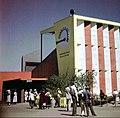History of the fair
The origin of the fair traces back to the Chicago and North Western Railway (CNW), which at the time was the successor of the first railroad to operate out of Chicago, the Galena and Chicago Union Railroad. CNW was seeking a way to commemorate 100 years of railroading in Chicago, especially as it was done on the CNW itself. Public Relations Manager F.V. Koval is credited with developing the idea behind the fair. [1] The CNW advertising and public relation staff went to work to promote the show in the early months of 1948, beginning with a series of photographs made by company photographer Don Lidikay of people in 19th century costumes posing with the locomotive Pioneer , which had pulled the first train out of Chicago in 1848. [1]
The fair was rapidly planned during the winter and spring of 1948, and originally scheduled to run between July and August of that summer. Erected on 50 acres (200,000 m2) of Burnham Park in Chicago between 21st and 31st Streets, [2] the fair opened after only six months of planning. A grand opening for the fair commenced on July 20 [1] with a parade that featured such spectacles as a military marching band and a replica of a troop train, a contingent of cowboys and Native Americans, a replica of the Tom Thumb, the first American locomotive, and the spry, octogenarian widow of Casey Jones, who served as honorary Grand Master of the parade. One dollar was the price of admission, and, except food, all the attractions, displays, exhibits and shows were free. Besides the thirty-nine railroads who participated in the fair, there were more than twenty equipment manufacturers, including General Motors. [3] The Santa Fe also sponsored an Indian Village where Native Americans sold handicrafts, staged dances, and explained the different types of lodging that were on display. [4]
A popular ride for visitors was the Narrow Gauge (3-foot) excursion train which ran the length of the grounds, charged at 10 cents per ride. [5] The train, supplied for the Fair by CB&Q, consisted of refurbished Colorado and Southern Number 9, a 2-6-0 built in 1882, and coaches, open observation cars and a railway post office car which had been built new by CB&Q in 1880's style. The train was lettered for the Deadwood Central Railroad, a defunct railroad in South Dakota. For the 1949 Fair, D&RGW provided a second train, with its own refurbished 2-8-0 number 268 and coaches, all lettered for the fictional "Colorado Springs and Tincup Railroad". [6] The complete "Deadwood Central" train was acquired in 1956 by the Black Hills Central Railroad, but the name was not continued. [7]
A highlight of the fair was the presence of the Freedom Train. The Freedom Train travelled the country from September 17, 1947, through Jan 22, 1949, and was at the Railroad Fair from July 5 – 9. It held many documents and artifacts from the National Archives. Available for public viewing were the original United States Constitution, Declaration of Independence and the Bill of Rights. Security of the documents was the responsibility of the Marine Corps.
The fair was open from July 20, 1948 to October 3, 1948 and June 25, 1949 to October 2, 1949. Attendance during 1948 was 2,500,813 people. In 1949 this attendance record was broken on September 25, 1949 a week before the fair closed. When the fair ended in 1949, a total of 2,732,739 people had attended that year. The highest date of attendance was Sunday, August 1, 1948 when 75,257 passed through the fair gates. It was the first Chicago fair where attendance in the second year exceeded the first year's total. [8] [9]











